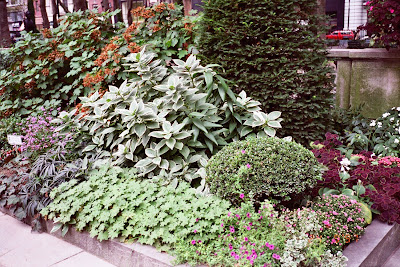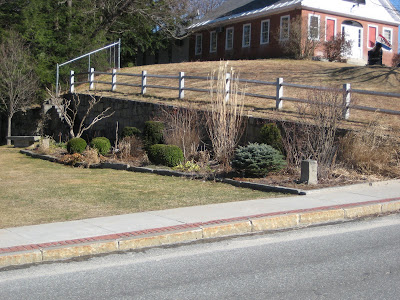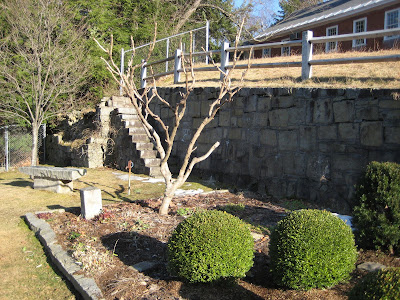
The gardener's eye
The Gardener's Eye
Wednesday, March 31, 2010
Garden Read: Take a Walk on the Wild Side

Sunday, March 28, 2010
And Now For a Little Color
It has been nearly a month since I have had a post with any color whatsoever. Well I guess that is the whole purpose of a spring flower show and the Boston Flower and Garden Show did not disappoint. I arrived early on the last day of the show with a friend before the crowds descended. The Boston Flower Show had been discontinued for a year and it has been reestablished as a new smaller show at the Seaport World Trade Center.
It will be a good month before northern New England experiences the spring flush of color my childhood home of suburban Philadelphia now enjoys. The Boston Flower and Garden Show was the perfect antidote to the beginning of the mud season here in New Hampshire.
Wednesday, March 24, 2010
Getting the Boccelli Garden Ready



and Salix purpurea ' Nana', right

 Miscanthus floridulus 'Giganteus
Miscanthus floridulus 'Giganteus
The Boccelli Garden, a mixed border, was cleared and prepared for the growing season. All the spent stems of the perennials were cut back. The leaves of the hellebores were removed to make way for the emerging flowers. The large grasses, Miscanthus floridulus 'Giganteus' and Miscanthus sinensis 'Silver Shadow' were cut to the ground. The rigid 8 foot long stems of Miscanthus floridulus 'Giganteus' are stored because they make excellent supports when staking plants during the growing season.
Three trees or large shrubs, Catalpa bignonioides 'Aurea', Gleditsia 'Ruby Lace' and Cotinus coggygria 'Royal Purple', are stooled, each to about 18 inches, to encourage robust new foliage. The catalpa leaves are huge chartreuse paddles that contrast well with the small leaflets of the purplish bronze compound leaves of the honeylocust tree. The rich maroon-red foliage of the smoke bush looks stunning against any foliage or flower color imaginable. In general, red, chartreuse and grey foliage are effective mixers with both hot and cool color schemes.
The seven foot tall Viburnum sargentii 'Onondaga' was limbed up so its branches do not overpower the underlying perennials. It was chosen for this border for its velvety maroon young foliage, creamy white flowers and red fall fruit. The old black stems of Rosa rubrifolia were thinned out to encourage new growth from the ground. The foliage has a beautiful grey color with a copper cast to it; the pink flowers are an added bonus.
The Ribes alpinum 'Aureum' was shaped slightly. Dan Hinkley, the famous plant hunter and founder of Heronswood Nursery, described this currant in the 2000 catalogue: "I have brought this back from England on three occasions, each time from suckering stems offered by Christopher Lloyd while walking his remarkable, cherished Dixter, and each time, but the last, losing the plant. Finally, we have this established in our garden, and finally we are able to offer but a few, with small brilliant yellow foliage (fading to lime as the season progresses), on stems forming compact mounded shrubs 4 ft. by 4 ft., in full sun and well-drained soil. For no extra fee, the magic of Dixter is eternally bound to each and every plant." Well, that sold me!!!
Finally, several dead or damaged branches of the Aralia elata 'Aureovariegata' were removed. This connoisseur's small tree has a bold winter skeleton and large compound leaves with golden edges. This particular specimen is the largest and happiest I have ever seen in a garden. To be quite honest, I am not sure why. I have killed the same plant in my own garden.
Now the garden is ready for the season to begin. You can see the Boccelli Garden in its full glory in the slideshow on the sidebar. Christopher Lloyd's book, Succession Planting for Year-round Pleasure, is an excellent resource on how to build your own mixed border.
The Waiting is the Hardest Part
Sunday, March 21, 2010
Wave Hill and the High Line in March



Railroad Tracks
Gridded Grove of Acer Triflorum

Garden View: Frank Gehry building and Jean Nouvel residential tower
I had an optometry symposium in New York City this weekend which gave me the opportunity to visit some public gardens in the Big Apple. On of my favorite gardens is Wave Hill, often called one of the most beautiful places in New York, which is in the Bronx. It is right off the Henry Hudson Parkway just north of the George Washington Bridge. It is one of the most southern of the great estates along the Hudson River and has magnificent views of the Palisades across the Hudson River. It became a New York City Park in the 1960's. The High Line is a brand new park on the West Side of Manhattan. It was originally an elevated railroad that was built in the 1930's to keep dangerous freight trains off the city streets. During the 1950's the trucking industry eclipsed rail traffic and the ultimately closed the High Line. In June, 2009, it became an elevated public park. Last Friday was my first visit to the High Line.
Late March is a great time to travel south when you live in New Hampshire. While we tend to remain blanketed in snow, spring is sprouting in New York City. Wave Hill and the High Line both offered excellent examples of public garden design. While they are very different, they have many similarities. The both have excellent structure which can be easily observed before the plantings emerge.
Wave Hill's Flower Garden is formally designed and is enclosed by a cedar fence which has a benches on two ends. It has what they call lozenge-shaped yew domes flanking the brick pathway. Later in the season, the garden will be full of an informal array of vintage and modern shrubs, perennials and tantalizing tender exotic plants.
The Wild Garden is inspired by William Robinson's writings in the early twentieth century. It contains plants from around the world and is planted in a "planted-by-nature effect." It has an antique gazebo, meandering gravel pathways and many varieties of evergreens which provide a backdrop to the elaborate plantings.
The High Line feels extremely modern, urban and gritty. Many of the plantings were designed by Dutch garden designer, Piet Oudolf. Oudolf specializes in perennial gardens that are influenced by the American prairie. The plantings were inspired by the self-seeded grasses and perennials that established themselves on the obsolete railway. The concrete plank pathways have a very contemporary feel to them. Sections of the rusted railroad tracks remain in their original location and are integrated into the plantings. The Asian tree, Acer triflorum, and our native grey birch, Betula populifolia, add bark interest and winter structure.
When I return from visiting inspiring public plantings in late winter, I try to take a hard look at my personal garden and the public parks that I work on in Peterborough. I ask myself what changes could be implemented to make the garden picture more beautiful and interesting in the winter and early springtime. I make every effort to visit excellent and diverse gardens and public places at different times of year for inspiration. Wave Hill and the High Line have a spirit of their own place and marry strong structure with unique (and in the High Line sometimes common) plants combined in very interesting ways.
Both Wave Hill and the High Line have plant lists on their websites that I found very helpful when I was studying their designs.
Saturday, March 13, 2010
On Drawing Gardens

Monday, March 8, 2010
First tulip of the season in New Hampshire

Wednesday, March 3, 2010
The Education of a Public Gardener: 9/24/97




























